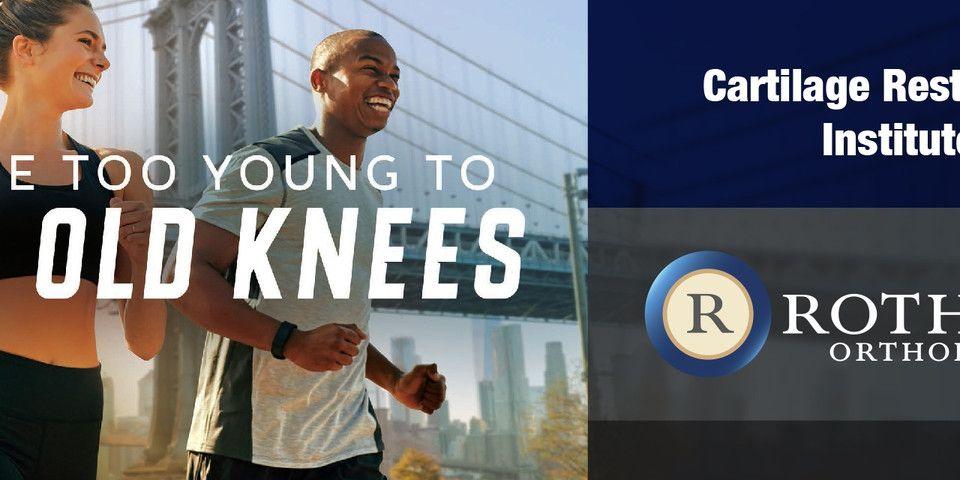Bilateral Total Knee Arthroplasty: Recovery
Don’t remain uninformed about what recovery from bilateral total knee arthroplasty requires.
When an individual’s mobility is limited and routine activities are disrupted by knee pain, it is possible that nonsurgical treatment methods may not restore one’s quality of life. If you’re feeling pain, have lost mobility, or both, and nonoperative treatment methods have been ineffective, it is time to seek treatment options from our orthopaedic surgeons at Rothman Orthopaedic Institute. If surgical treatment is advised, there are essential facts about recovery from bilateral total knee arthroplasty that every patient should know before scheduling the procedure.
What is Knee Replacement Arthroplasty?
A total knee replacement removes damaged bone and cartilage from the thighbone, shinbone, and kneecap. A prosthesis, or artificial joint, made of metal, high-grade plastics, and polymers is implanted into the knee and serves as a replacement for those parts of the knee that were removed. The basic steps involved in every arthroplasty, or knee “replacement” include:
-
Preparation of healthy bone and removal of damaged bone
-
The positioning of the metal implants with either cement or by “press-fit” to recreate the joint surfaces
-
Resurfacing of the patella
-
Insertion of a spacer to create a smooth gliding surface
A bilateral total knee replacement is necessary when the cartilage has worn away in both knees. There are two different types of procedures: a simultaneous bilateral total knee replacement (in which both knees receive a prosthesis on the same surgical intervention, under one anesthesia) and a staged bilateral total knee replacement (in which both knee replacements take place as two separate surgical events several months apart). The decision to pursue surgical treatment should be a cooperative one between you, your orthopaedic surgeon, and loved ones. By seeking advice from the experts at Rothman Orthopaedic Institute, you will have a better perspective on what bilateral knee replacement pros and cons you may face for your specific condition and recovery.
What to Expect During Recovery
Candidates for knee replacement should seek surgical treatment for the purpose of pain relief and management, as well as, increased stability and function. It is important to maintain reasonable expectations about bilateral total knee replacement recovery time and rehabilitation. Patient compliance is a very real necessity that can determine whether a patient successfully recovers or experiences difficulties with the new artificial joint. Here, Rothman Orthopaedic Institute wants to inform you about what you must do during recovery from a bilateral total knee arthroplasty to ensure favorable long-term outcomes:
1. Remain attentive to wound care.
Some of the initial risks associated with a knee replacement surgery include wound infection, infection in the prosthesis, and poor wound healing. You will be given antibiotics before the start of your surgery and these will be continued for 24 hours afterward to prevent infection. Following the surgery, you may spend a day at the hospital under the supervision of your doctor. While recovering at home, keep the wound away from water, and bandage the wound to prevent irritation. If staples were used, they will run along the length of the incision point, and will need to be removed two weeks after surgery. Immediately notify your doctor if these signs of infection arise:
-
Fever higher than 100 °F
-
Chills
-
Redness, tenderness or swelling
-
Drainage from the wound
2. Be diligent with your physical therapy requirements.
Bilateral total knee replacement physical therapy protocol requires that patients begin exercising their knee after the procedure. Maintain your visits with a physical therapist so that you may strengthen your legs and restore knee movement. Normal daily activity should resume within three to six weeks following surgery.
3. Follow your doctor’s instructions to prevent complications.
Total knee arthroplasty procedures at Rothman Orthopaedic Institute have excellent results, and patients should expect a greater than 95% chance of success at 15 years. But, it is important to be aware of the risks of complications that may arise during your recovery. Although rare, these complications include blood clots, infection, injury to the nerves or vessels, and continued joint pain. If signs of complications arise, it is crucial you seek the help of your orthopaedic specialist immediately to ensure a full recovery from bilateral total knee arthroplasty.
For more information, please visit us here or contact us at 1-800-321-9999.
Related Specialties
Related Conditions
Related Treatments
Related Programs
-

Cartilage Restoration Institute
This is a center where patients can go to have their disabled joint biological resurfaced, realigned, and stabilized without having the joint replaced by artificial materials such as metal and plastic. It is well known that the outcomes of patients under the age of 50 undergoing artificial joint replacement are not as good as we would like. Therefore we feel the future of Orthopaedics is to try to restore a joint back to its original anatomy by realignment, ligament reconstruction, and cartilage restoration.Read More




